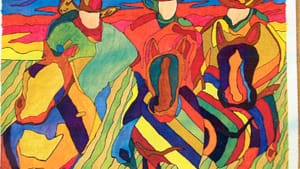Stay in the Loop
BSR publishes on a weekly schedule, with an email newsletter every Wednesday and Thursday morning. There’s no paywall, and subscribing is always free.
The world in a prison cell
Light and shadow in a prison cell

The first art class that I volunteer to teach in this prison is held in an older 1920s vintage building on the far side of the prison yard. The light is harsh in this building, but I like the building. It reminds me of a Northern European sanatorium. I’ve never been in a sanatorium and can’t even say that I’ve ever seen one. However, when I imagine a sanatorium, this prison is how it looks.
In this prison building there is very little on the walls and only minimum furniture. The building is pure space, as if emptiness is the cure.
I like empty buildings. Perhaps the emptiness reminds me of an unmarked canvas that in its blankness offers a hope of movement to the artist— movement, because hope in general is too vague and therefore potentially stagnant. When I first built my art studio, there was nothing in it; the studio existed as a cement floor, white walls and a ceiling. I spent hours drawing the expanse of the studio, knowing that soon objects would compromise the space.
The same was true of my house when it was first built. The first floor of the house is one large room with a center height of 20 feet. At first the house contained few objects to detract from this pure space, other than a piano, a table and two plastic chairs. The house did not consist of objects; it consisted of space.
Unfortunately now, the space is a collection of things: books, a sofa, oversized comfortable chair, the same piano, two tables and chairs inherited from my mother-in-law. The expansive center ceiling 20 feet above the floor of this large room has collected 15 years of cobwebs. My house lost its initial pure space but gained the patina of time.
Why artists like prisons
So when I visit this prison I’m drawn to its empty space. Of course, I don’t live there. I did tell the superintendent on my initial tour that when he has freed all the prisoners, the artists could move into the prison, occupying the cells as studios. I have seen installations at old prisons, so I assume that the fascination with prison space is common to artists.
Living in prison is theoretical to me. But before falling asleep one night, I imagined the horrid, claustrophobic sensation of being in a small cell, never to be allowed out, and never to move around. What does one do for hours, living alone in solitary confinement? In this spilt second jolt I felt why Billy, a student participating in my through-the-mail art curriculum, hung himself after six years in solitary confinement with only one daily hour outside his cell. Empty space that I choose voluntarily is different than empty space that is forced upon an individual.
Animals in silhouette
In this prison room where the light is harsh and I teach face-to-face with the prisoners, students are drawing. I take advantage of the harshness and demonstrate the two sides of light. On the single long table I arrange a menagerie of well-rendered plastic toy animals— camels, elephants, cows, lions, pigs, fish, horses, rhinoceroses, bulls, dogs, okapi, swans, giraffes, cobras and zebras.
The animals take over the entire top of the long table. I point out to the prisoner-students sitting on the far side of the table—where they face the harsh light coming through the large windows—that they are seeing the animals’ silhouettes. From their side of the table, with the harsh light as the backdrop, all form within the toy animal is totally destroyed. The students can see the only relationship between “light-on” (the “negative” space surrounding the toys) and “light-off” (the toy). One prisoner jokes how he certainly understands the light-off part, implying that his mental light is always off. That’s good, I tell him, because we’re not using our brains— only our eyes.
If the prisoner-student sits on the far side looking into the light, he cannot possibly draw form unless he mentally represents the animal as he thinks it should be represented. He might remember that the horse has an elbow, but he doesn’t see that elbow in this darkness of the silhouette. I want him to draw what he sees, not what he thinks.
What you think you see
As a mental representation, the artist doesn’t experience the world through drawing; the artist makes a representation of the world through what he/she expects theoretically. This is a point that I need to make over and over again: the difference between the world as a representation and the world of experience.
If the students sat here at the table drawing this menagerie of toy animals all day long, they would experience how light and shadow constantly make visible the forms of the toy animals; new forms are seen and old forms become less visible as the light changes. If the prisoners sat at this table looking at these animals into the next day, obviously they would experience a repetition of daylight with more, less or similar intensity than today’s harsh light.
Light returns not as a reminder but as a challenge to see the world differently. If we did sit at this table for days, each day’s assignment would be to draw something new as the light and shadow are cast upon the animals. Or we might include the entire room into the discovery process.
Transcending boredom
At some point, memory may be, and usually is, warranted in art. But for now, the drawing focuses on the immediate experience of light and shadow.
In another prison, a student draws the prison yard poles that he can see from his rec pen, that kennel-like structure off a prison cell that permits the prisoner to walk three feet out of his cell. For weeks, this prisoner sits in his rec pen, drawing the light upon the poles and the shadows this light casts from these poles. This prisoner is serving a life sentence and comes to see the light, shadow and poles as sundial-like structures marking time for him; an incarcerated Stonehenge.
Eventually, the prisoner becomes bored from drawing the cast shadows of the poles. When the seasons change, he realizes that the light has changed. It’s more yellow, lower on the horizon, and again he begins drawing the ever-changing light and shadow patterns cast by the poles.
“All these years,” a prisoner serving a life sentence writes to me, “I have been creating art to get away from this place. You are asking, however, for me to go into this experience of actual living; to move through this space in order to create art.”
Yes, I am. The act of drawing, even in prison, gives access to an experience of one’s world. Prisoners, like most people, typically think that drawing is “about” something— a picture of something. But when drawing is the process in which the artist discovers the world, it becomes a dynamic experience. Patterns of light and shadow are merely one visual affirmation of infinite perpetual change. In this experience, the prisoner-artist doesn’t enter the same prison cell twice.
Sign up for our newsletter
All of the week's new articles, all in one place. Sign up for the free weekly BSR newsletters, and don't miss a conversation.

 Treacy Ziegler
Treacy Ziegler